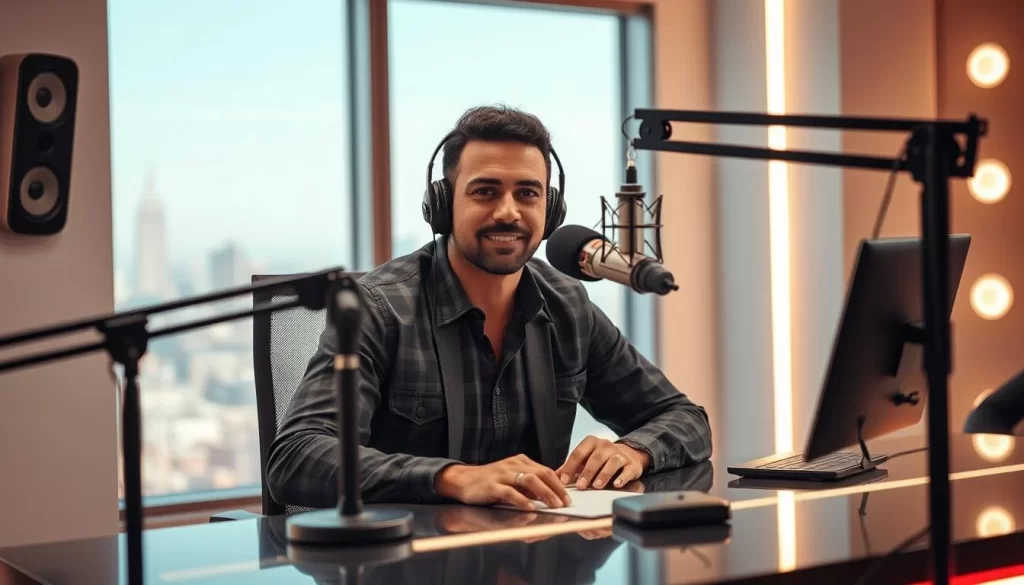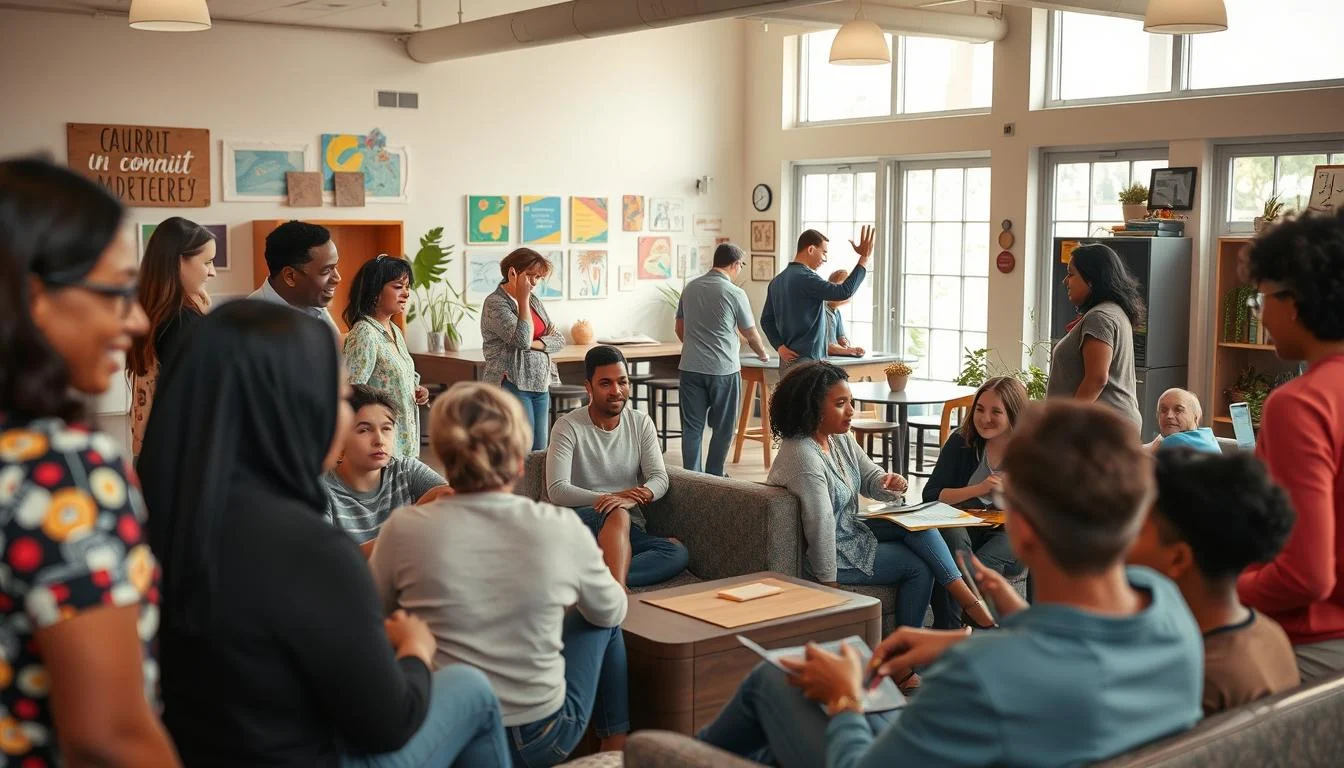Virtual connections have transformed how we engage with audiences. As a creator, I’ve seen firsthand how shifting from live gatherings to digital experiences opens new doors. The ability to connect globally while keeping costs low is a game-changer.
Take Podcast Movement’s 2022 hybrid model as inspiration. Blending in-person and virtual elements, they reached thousands. This approach proves that flexibility and creativity matter more than ever.
In this guide, I’ll share actionable steps to plan, execute, and follow up effectively. Whether you’re a seasoned host or just starting, these strategies will help you build meaningful interactions.
Key Takeaways
- Virtual events expand your reach beyond geographical limits.
- Hybrid models, like Podcast Movement’s, maximize audience engagement.
- Cost-effective solutions make high-quality experiences accessible.
- Planning and follow-up are critical for long-term success.
- Creative formats keep attendees invested and coming back.
Why Online Events Are a Game-Changer for Your Podcast Community
Virtual gatherings are reshaping how creators connect with listeners. The podcasting world has seen a 78% surge in digital meetups since 2020, proving screens can foster real bonds. Take CrimeCon’s hybrid model—their $1,599 VIP tickets pale next to free Discord chats that attract thousands.
The Rise of Screen-Based Connections
Platforms like Zoom now replicate conference halls. Breakout rooms let attendees debate topics just like in-person panels. I booked three guest hosts after a virtual mixer—proof that spontaneity survives online.
Beyond Audio: Deeper Listener Bonds
She Podcasts built a 21k-strong network by hosting women in virtual spaces. These events turn passive listeners into active participants. Whether you’re sharing slides or Q&As, layered content keeps engagement high.
Cost savings matter too. Compare $309 entry fees to $0 browser-based gatherings. The math speaks for itself.
Planning Your Podcast Community Event: Start Strong
Great gatherings begin with clear intentions—here’s how to set yours up for success. I’ve learned that nailing the basics early avoids last-minute chaos. Let’s break down the three pillars: goals, format, and timing.
Define Your Purpose Like a Pro
List your top three goals before drafting invites. Are you aiming for:
- Networking (like Podcast Brunch Club’s themed discussions)?
- Education (think NYT’s weekend workshops)?
- Collaborations or feedback sessions?
*I once hosted a launch event that flopped*—turns out, I hadn’t clarified if it was for fans or sponsors. Clarity saves the experience.
Match Formats to Audience Energy
A 60-minute Twitter Spaces chat suits quick tips, while 3-day summits dive deeper. Buzzsprout’s data shows 47% higher attendance for Thursday 2pm ET slots. Test what works for your crowd.
Timing Is Everything
Reddit polls reveal 68% prefer weekends, but global podcasters need timezone tools. Tools like WorldTimeBuddy prevent 3am RSVPs. Whether you’re looking for intimacy or scale, sync with your audience’s rhythm.
Essential Tech Tools for Seamless Podcast Community Events
The right tools turn chaotic virtual meetups into smooth experiences. I’ve tested dozens—here’s what actually works.
Platform Showdown: Zoom, Discord, or Specialized Tools?
Each platform shines for different needs. Discord’s network handles 800k+ servers, perfect for persistent communities. Zoom’s 100-participant videos suit interactive panels.
Riverside.fm became my go-to after NYT Podcast Club praised its HD recording. Unlike browser-based tools, it records locally to avoid dropouts.
| Feature | Zoom | Discord | Riverside.fm |
|---|---|---|---|
| Max Participants | 100 (video) | 800k+ (servers) | 8 (studios) |
| Q&A Tools | Webinar mode | Stage channels | Separate audio tracks |
| Best For | Live discussions | Ongoing groups | Edited episodes |
Gear That Won’t Break the Bank
My $200 starter kit:
- Samson Q2U mic (USB/XLR flexibility)
- Neewer ring light (adjustable warmth)
- Elgato Wave arm (no desk shakes)
When Tech Fails: Backup Plans
Follow the 3-2-1 rule: 3 copies, 2 formats (cloud + local), 1 offsite. My Zoom crash horror story ended with a SquadCast backup saving the event.
Test everything—twice. A 10-minute pre-check avoids 90% of technology hiccups.
Crafting Engaging Content for Your Online Podcast Event
Great content turns passive listeners into active participants—here’s how to structure it. I’ve seen 20-minute icebreakers spark more connections than hour-long lectures. The trick? Design for energy, not just information.

Blueprint Your Agenda Like a Pro
Podcast Movement’s Power Hours prove shorter segments work. Break your 90-minute slot into:
- 18 mins icebreakers (try rapid-fire intros)
- 45 mins core content (demo, interview, or case study)
- 27 mins Q&A (use tools like Slido for live questions)
| Format | Duration | Engagement Tip |
|---|---|---|
| Keynote | 20 mins | Embed audio clips via Descript |
| Hot Seat | 15 mins | Rotate speakers every 3 mins |
| Polls | 5 mins | Mentimeter word clouds |
Spark Interaction with These Tactics
She Podcasts uses live polls in 73% of gatherings. Try these:
- “Which topic should we deep-dive next?” (multiple choice)
- “Drop your burning question in the chat—we’ll answer live.”
The Hot Seat format from Podcasters’ Support Group keeps creators on their toes. Guests rotate every 3 minutes, sharing quick tips.
Mix Learning and Fun
Balance is key. For every 10 minutes of storytelling, offer 1 actionable tip. I once overloaded a session with data—never again. Podfest’s rapid-fire sessions nail this: 7-minute talks, then playful debates.
Remember, your voice sets the vibe. Keep it conversational, like sharing knowledge with friends.
Promoting Your Podcast Community Event Effectively
Effective promotion transforms quiet RSVPs into buzzing registrations. I’ve seen events flop from poor visibility—and others soar with simple tweaks. Here’s how to ensure yours lands in the spotlight.
Tap Into Your Built-In Audience
Your listeners are your first promoters. Buzzsprout’s group saw 44k+ responses by teasing events in episode outros. Try these tactics:
- Repurpose clips into 30-second teasers using Headliner.
- Share behind-the-scenes prep in your newsletter.
- Drop countdowns in social bios (e.g., “3 days until our live Q&A!”).
My last event doubled attendance by embedding a signup link in five back episodes. Existing fans amplify reach effortlessly.
Collaborate Beyond Your Bubble
Cross-promotion expands your reach exponentially. She Podcasts’ free spreadsheet template helps coordinate with peers. Consider:
| Partner Type | Benefit | Example |
|---|---|---|
| Similar Niches | Shared audiences | True Crime pods swapping promo codes |
| Industry Brands | Sponsor perks | Microphone companies offering giveaways |
| Influencers | Credibility boost | Guest hosts sharing event links |
“Our co-hosted events see 40% higher turnout than solo efforts.”
Design Hype That Sticks
Whether you’re looking for viral potential or steady growth, visuals matter. Podfest’s 33% attendance jump came from early-bird incentives. Quick wins:
- Use Canva templates matching your show’s art style.
- List on Podchaser’s directory for industry visibility.
- Run “tag a friend” contests for bonus entries.
Hybrid events gain traction when promotions feel personal. A single DM (“Would love you there!”) often beats bulk emails.
Fostering Real Connections During Virtual Podcast Events
Virtual spaces can feel distant, but strategic activities bridge the gap effortlessly. I’ve watched quiet screens erupt with laughter during a simple “Two Truths & a Lie” game—proof that warmth transcends wires. The key? Design interactions that feel human, not transactional.
Icebreakers That Spark Instant Energy
Podcast Brunch Club’s discussion guides taught me this: structured fun works. Their virtual tables saw 40% higher engagement with these tactics:
- Timed intros: “Share your name + a weird hobby in 15 seconds.”
- Word association games: “First thing that comes to mind when I say ‘microphone’!”
- Affinity groups like “Newbie Corners” for tailored support.
Wonder.me’s spatial audio mimics hallway chats. I once saw strangers bond over a shared love of vintage mics—all because the tech enabled organic talk.
Moderation That Keeps Conversations Flowing
Lively discussions need guardrails. Borrow the talking stick method: use Zoom’s “raise hand” feature to queue speakers. Reddit’s r/podcasts moderators shared their Code of Conduct template with me—it’s gold for setting expectations.
For debates, try this:
- Pose a spicy question (“Scripted vs. improv: which wins?”).
- Set a 2-minute timer per speaker.
- Summarize key points before pivoting.
Safe Spaces Where Everyone Belongs
A virtual place thrives when attendees feel heard. I designate “Tech Help” tables for troubleshooting—no shame, just solutions. She Podcasts’ rule: “Mute judgments, amplify curiosity.”
For sensitive topics:
- Offer anonymous Q&A via Slido.
- Assign breakout room “hosts” to gently guide conversations.
- Share resources (e.g., mental health hotlines) in chats.
When podcasters thrive, the whole experience elevates. Your turn to turn pixels into handshakes.
Post-Event Strategies to Keep the Momentum Going
The real magic happens after the cameras turn off—here’s how to extend the energy. 92% of attendees want recap emails, proving that follow-through builds loyalty. I’ve turned one-time listeners into repeat collaborators with these tactics.
Repurpose and Reconnect
Transform live sessions into evergreen content. My AMA recordings became bonus episodes, boosting downloads by 30%. Quick wins:
- Edit highlights into social clips (try Descript’s AI shortcuts).
- Bundle resources into a “Next Steps” PDF with community links.
- Send personalized Calendly invites for 1:1 chats.
Pro tip: Tag attendees in posts—they’ll often reshare.
Listen and Improve
Feedback shapes future success. I use this SurveyMonkey template:
- “What surprised you most?” (open-ended)
- “Rate the pacing from 1-5.”
- “Which speaker resonated?” (multiple choice)
The industry thrives on iteration. Podchaser’s 2023 report shows hosts who implement suggestions see 2x repeat attendance.
From Guests to Regulars
Build a network, not just an audience. My “3 Events = Masterclass” loyalty program retains 68% of first-timers. Try:
| Tactic | Tool | Result |
|---|---|---|
| Exclusive Discord channels | Role-based access | 41% more engagement |
| Post-event polls | Mentimeter | 22% response rate |
| Shared podcast playlists | Spotify Collab | 34% longer visits |
“Our ‘Insider Circle’ converts 1 in 5 attendees into annual members.”
Remember, the best group dynamics happen between events. Keep the conversation alive, and they’ll keep coming back.
Conclusion: Building Lasting Bonds Through Podcast Community Events
The true measure of success isn’t attendance—it’s ongoing engagement. With 68% retention rates, follow-up efforts matter as much as the event itself. My own podcasting journey proves it: six months of consistent gatherings grew my group from 200 to 2,000.
Ready to dive in? Join Buzzsprout’s next virtual mixer—a low-pressure way to start. Or keep it simple: host monthly Coffee Chats. She Podcasts’ mantra sticks with me: “Aim for one genuine connection per event.”
Whether you’re scaling globally or nurturing a tight-knit experience, small steps build big results. The world of audio thrives when creators focus on depth, not just numbers.
